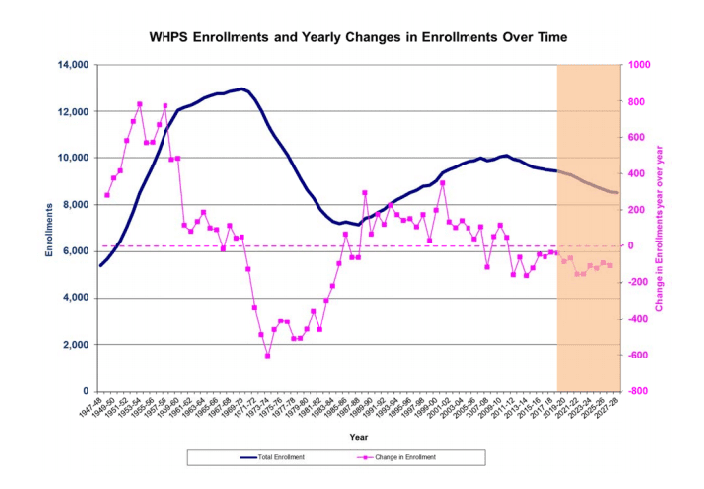Gradual Enrollment Decline Predicted for West Hartford Public Schools

Audio By Carbonatix

Photo credit: Ronni Newton (we-ha.com file photo)
Adequate space in West Hartford’s school buildings is anticipated.
By Ronni Newton
Enrollment is predicted to undergo a gradual decline in West Hartford over the next 10 years, Director of Finance and Planning Chip Ward told the Board of Education Tuesday night.
The enrollment for the current year, 2017-18, is at 9,400 students, about 60 students less than the number enrolled the previous year, Ward said. In his report to the Board, Ward is projecting that 9,367 students will be enrolled in West Hartford Public Schools next year, a decline of 33 students, and he is projecting a gradual decline of about 94 students per year, to a population of 8,456 for the 2027-28 school year.
Ward has been producing enrollment projections for the Board for about 20 years. The thorough presentation, an analysis of the “Cohort Survival Rate” (CSR) which tracks a cohort of students from birth to kindergarten and between grade levels, is “a fantastic study of where we are and where we’re going,” as well as a look back on the history of the schools, Superintendent Tom Moore said.
The enrollment analysis dates back to 1947-48, when the population was 5,402 and began rapid growth of 575 students – more than one elementary school’s worth – per year. In the 1970s through mid-1980s, the enrollment dropped from a peak of 12,826 to 7,283 – a decrease of about 425 students per year, Ward’s report states.
The Baby Boom echo turned the trend in the other direction, and from 1988-89 through 2010-11, with a growth of 100-200 per students per year, back up to 10,091.
“Because we didn’t have the facilities we had a space crunch,” Ward said. Classrooms were added at all of the schools, with 3o modulars installed.

Screenshot from ‘Enrollment Projections’ reported by Chip Ward, Dec. 19, 2017
Declining enrollment is a trend that most districts in the state are facing, but it is less of an issue in West Hartford than in other towns. “We have one of the lower rates of decline,” Moore told the Board. In his report, Ward noted that West Hartford “continues to maintain a growing share of births in Connecticut,” which is reflected when those students enroll in kindergarten five years later.
The CSR from birth to kindergarten in West Hartford has traditionally been in the 1.06 range, other than in three recent years when it dipped below 100 percent. This year the ratio returned to 1.04.
Ward said that after extensive analysis there was no clear reason or explanation why there was a lower CSR from birth to kindergarten for those three years. “The data was clear – we didn’t lose them they just left.”
Factors influencing CSR, Ward said, include: families moving to West Hartford for its schools, students attending private/parochial/magnet schools, families moving in or out of West Hartford due to economic reasons, and turnover in real estate market as new families move in and old ones move out.
The average CSR over all grade levels for 2017 is 1.015, one of the highest West Hartford has ever had, Ward said.
With declining birth rates, however, the enrollment with naturally decline, beginning at the elementary school level. The elementary population is projected to drop from the current level of approximately 4,100 (which has already dropped from 4,680 in 2009-10) to a low of 3,700 in 2024-25, and then stabilize.
As those smaller classes move through the system, middle school enrollments should decline from 2,200 to 1,900. At the high schools, where the population has continued to fluctuate between 3,000 and 3,100, the total number of students will eventually drop to about 2,800.
While there are not plans to close any buildings, Board Chair Cheryl Greenberg asked Ward about closing down the temporary classrooms. He said that it’s often costlier to take down the classrooms than it is to leave them in place. “We are looking at expedited removal of classrooms” where there is certainty that they will not be needed, he said.
After years of bursting at the seams, “at this point we’re kind of getting some elbow room again,” Board member Dave Pauluk said. “We’re just going back to where we were.”
Wolcott’s art room had been moved to the basement, where there were no windows, and Duffy had to repurpose a locker room, Moore said. Those accommodations will no longer be needed.
The fluctuation will be spread among the schools, however the enrollment at magnet schools Smith STEM and Charter Oak International Academy, can be controlled, Moore said, with Charter Oak’s population expected to climb as planned.
“Both have attracted more and more students. We are at an all time high for magnet applications and placements,” Moore said.
Ward’s complete report can be found here as an attachment to the Board of Education agenda.
Like what you see here? Click here to subscribe to We-Ha’s newsletter so you’ll always be in the know about what’s happening in West Hartford!



